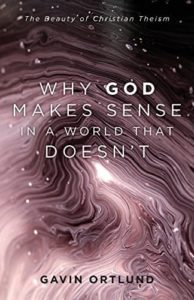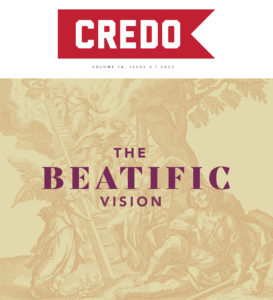Jon Tyson, a pastor in New York City, recently reflected on a conversation he had with Tim Keller in 2006. Tyson quotes Keller, “We are exposed to so much brokenness in the city, we must constantly expose our hearts and minds to beauty.” Keller captures the significant restorative potential of beauty as it stands in contrast with the heaviness and destructive impact of sin in the world. Compelling. It resonates. Yet in its simplicity, the statement also bewilders. How does one do this? Where should one look? In W hy God Makes Sense In A World That Doesn’t, Gavin Ortlund points every person longing for beauty, convinced of its very need, to the Triune God of Christianity: Father, Son, and Holy Spirit. At its root, the search for transcendent beauty is not a pursuit limited to the Christian or the more broadly religious, it is for every person created in the image of God. As Ortlund writes, “My hope is that this book will help you feel, in perhaps some new way, the beauty of the gospel—that feeling of hope and goodness like when, at long last, the night is over and the sun starts to rise” (16).
hy God Makes Sense In A World That Doesn’t, Gavin Ortlund points every person longing for beauty, convinced of its very need, to the Triune God of Christianity: Father, Son, and Holy Spirit. At its root, the search for transcendent beauty is not a pursuit limited to the Christian or the more broadly religious, it is for every person created in the image of God. As Ortlund writes, “My hope is that this book will help you feel, in perhaps some new way, the beauty of the gospel—that feeling of hope and goodness like when, at long last, the night is over and the sun starts to rise” (16).
Gavin Ortlund is well-positioned to author a book that argues for the transcendent and soul-satisfying beauty of the Creator God. Ortlund serves as the senior pastor of First Baptist Church in Ojai, California. He holds a Master of Divinity degree from Covenant Theological Seminary and a doctorate in Historical Theology from Fuller Theological Seminary. He is also the author of several other recently published books including Theological Retrieval for Evangelicals and Finding the Right Hills to Die On. In a way, Why God Makes Sense is a book marked by the confluence of skill and insight demonstrated in these two previous books: a historian’s careful, patient engagement with primary sources on the one hand and the discerning thoughtfulness to weigh contemporary issues and offer a compelling way forward. Ortlund also began Truth Unites, producing video dialogues and reflections which exist “to provide an irenic voice on theology, apologetics, and the Christian life….More than ever, it is important to commend the gospel in ways that are winsome, compelling, and unifying.”
Synopsis
Ortlund’s Why God Makes Sense In A World That Doesn’t is structured around four chapters that progressively argue from general theism to orthodox Christianity, that in Jesus Christ one finds satisfying supremacy of beauty and desirability he or she has been looking for all along. Each chapter is forty to fifty pages in length, filled with careful, reasoned engagement with contemporary sources, many of whom argue for an atheism stemming from commitments to scientific naturalism. The block quotes and heady topics like quantum physics should not intimidate readers. Ortlund writes as one who has meaningfully spoken with others about these topics, not simply written about them from a distance.At its root, the search for transcendent beauty is not a pursuit limited to the Christian or the more broadly religious, it is for every person created in the image of God. Click To Tweet
Ortlund’s Preface and Introduction give personal background and compelling vision for his aim in writing. Within these few pages, Ortlund also provides his three important characteristics for the book’s argument. First, he is focused on the desirability of Christianity as developed from Blaise Pascal, “Whatever else you conclude about the Christian story, my goal is that you will at least feel something of its wonder and enchantment” (4). Second, Ortlund also chooses to argue with a story-based format, not neglecting rigorous proofs, but viewing his argumentation “as entry points into a larger, more cohesive question: What is the overall shape of reality? What kind of story best explains our world” (9)? Third, he describes his abductive approach to his arguments which “works backward from a present set of conditions to the most likely explanation” (12). Thus, Ortlund’s arguments function comparatively, weighing various responses to each chapter’s topic while working toward which one provides the best, most reality-matching, beauty-describing answers.
The first chapter, entitled “The Cause of the World,” considers how the universe came into being. Ortlund engages over the course of almost thirty pages with the likes of Bertrand Russell, Stephen Hawking, and Lawrence Krauss about the cause or lack thereof behind the existence of the universe. His conclusion: it seems best to conclude that there is Something, a First Cause, behind the universe. However, the chapter does not end there. True to his proposed methodology, Ortlund turns the argument to address how the existence of a supernatural Something “makes reality more interesting” (45). His interest in the chapter is not simply to provide a survey of atheist arguments with cogent rebuttals, but to work toward how the reasonable conclusion of a necessarily-existing Supernature is metaphysically better.
The second chapter, entitled “The Meaning of the World,” moves the point of argumentation from the existence of the supernatural to a theism marked by purposeful, authorial intention. Ortlund demonstrates this by interacting with three foundational topics: math, music, and love. As in chapter one, Ortlund patiently and charitably interacts with previous and contemporary writers on each of these meaning-imbued topics, finally concluding, “theism allows us to live within our humanity more comfortably” (110).
The third chapter, entitled “The Conflict of the World,” continues to move the point of argumentation from a general, albeit purposeful, theism to a theistic personality who is not only intelligent but good. Ortlund analyzes the threads of conflict between good and evil woven throughout human experience as encountered in morality, the human conscience, and stories. As in the previous chapters, Ortlund argues that the overarching presence of a divine Author is not only more rational but more tangibly real, “We relate to [this Supernature] not as a kind of theory or postulate but at a gut level—at the same level at which we fall in love or face death” (159).
The fourth chapter, entitled “The Hope of the World,” continues the progressive sharpening of argumentation to the specific solution to the problem of evil discussed in the previous chapter: the resurrection of Jesus Christ. As Ortlund puts it, “At this point we turn from the general matter of whether God exists to a more concrete question: Supposing he does exist, how (if at all) might we locate him” (163)? To answer this question, Ortlund investigates the claims of Jesus culminating in the testimony of His resurrection from His followers. As before, he carefully engages with contemporary critics of Jesus including topics such as historicity, legend-making, and textual criticism. And, like previous chapters, Ortlund concludes with the supremely satisfying existence of God in the reality of the resurrection of Jesus Christ.
Evaluation
Ortlund effectively marshals his case for the supreme beauty of the Triune God of Christianity, utilizing themes of desirability, contemplation, and narrative to do so. As he concludes, “According to the way of thinking we have pursued throughout this book, the Christian story is not only a more plausible story than its naturalist counterpart but more interesting, more elegant, more dignifying to humanity, and more hopeful” (209).
Though rarely addressed, one of the strengths of this book that contributes to the success of Ortlund’s argument is its contemplative pace. Early on in Ortlund’s introduction, he reflects on Pascal’s statement regarding the skill of sitting quietly and alone in a room and its connection with happiness. He concludes, “This is Pascal’s point: if we could stay quietly in our room, we’d be forced to slow down enough to attend to our true condition” (p. 8). And Ortlund intends to slow each reader down who picks up his book; not to introduce a wearisome task—“Down with boring books” (p. xi)!—but to honestly engage the malaise of cultural disenchantment that Ortlund has diagnosed. How does he do this?Ortlund effectively marshals his case for the supreme beauty of the Triune God of Christianity, utilizing themes of desirability, contemplation, and narrative to do so. Click To Tweet
First, he patiently and thoroughly engages with atheistic and naturalistic thinkers. At times, readers may find him painstaking in his efforts! For example, over the course of several pages in chapter one, Ortlund analyzes A Universe From Nothing: Why There Is Something Rather Than Nothing by Lawrence Krauss. He does so slowly, not merely providing a short critical summary, but working his way through Krauss’s arguments. And he finds them wanting, “Krauss has passed from the realm of physics into the territory of philosophy. Ironically, the very preference for scientific theories of how the universe developed rather than the ultimate philosophical issue of absolute nothingness is itself a philosophical outlook not required by any scientific evidence” (41).
Second, as proposed in his methodology, Ortlund adds compelling narrative to careful reasoning. The stories he draws upon lead the reader to contemplate or, to borrow from C. S. Lewis, to “look along” as well as “look at” the arguments he proposes. From Puddleglum’s rebuttal of the Green Lady’s soothing lies in The Silver Chair to the singing of stars as they join in with Aslan in the song of creation in The Magician’s Nephew, Ortlund draws on the rich imagery of Lewis’s Narnia to capture the beauty of his arguments. In chapter three, he rallies Lewis, Dostoevsky, and Tolkien to help readers feel both the presence of moral tension and the real, tangible importance of the triumph of good over evil. His movie references powerfully connect readers with hopelessness in face of grave danger in The Grey and wonder at renewal that seemed beyond hope in X-Men: Days of Future Past. In these examples and many more, Ortlund leads the reader to contemplation, not merely to see or experience entertainment as contemporary culture so often expects, but to reflect and inquire as to the believing and the desiring that resides beneath the experienced response.
Third, Ortlund captures the thrill of discovery, the satisfaction of Christian theism, as he connects reason with reflection in each chapter. But his work is no house of mirrors. His methodical process establishes the credibility of theism over against the arguments for scientific naturalism repeatedly, but then the reader encounters the reality presented by Christian theism that extends beyond plausibility to desirability. For example, Ortlund concludes his section on music with this striking contrast, “On a naturalistic worldview, music is like an opiate for a dying man. It is pleasant in such a way as distracts us from reality….On a theistic view, by contrast, music is like a window to an imprisoned man. It is pleasant insofar as it is a portal into ultimate reality” (101).
In a footnote regarding Pascal’s wager, Ortlund describes his primary audience as one and the same with Pascal, “those who are halfway between belief and unbelief” (213). For those who find themselves weighing Christian theism over against scientific naturalism, the reviewer heartily recommends this book—yet the list of those who would benefit from reading it extends far beyond the undecided. The weary, disenchanted Christian would benefit from a reminder of the solid ground beneath his feet and the coming glory upon which to set his eyes. A deconstructing person investigating a post-Christian identity may be refreshed and reoriented by Ortlund’s gracious tone and persistent challenge to look and see the beauty of the Triune God. Bewildered Christian leaders tracing the shift of interest Ortlund observes from what is right to what is good may find their souls stirred and their minds equipped for a new generation asking different questions but truly longing for the same God of Abraham, Isaac, and Jacob.


